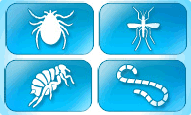Give
your dog a good quality feed. The type of feed should be appropriate
to the age of the Miniature Pinscher (baby, adult, senior) and the
amount provided shall be in accordance with their size. Keep fresh
water available to your dog.
Foods
to Avoid
- Homemade food: especially if any seasoned with spices, including salt.
- Chocolate: is poisonous and can be fatal to the dog. Symptoms of chocolate poisoning are vomiting, diarrhea, apnea, thirst, convulsions, hyperactivity, cardiac arrhythmia and possibly death.
- Coffee / Caffeine: has the same effect as the chocolate.
- Alcohol: can cause vomiting, diarrhea, incoordination, apnea, blood acidity, coma and death.
- Onions, garlic and chives: in every way, dried, fresh, cooked, because irritates the gastrointestinal tract of the dog.
- Grapes and raisins: can cause kidney failure.
- Avocado: can cause vomiting, diarrhea and heart problems.
- Yeast: The yeast will continue to grow in the stomach of your dog and can cause bloating, gas (dogs can not belch) and even rupture of the intestines and stomach.
- Meat and eggs: as well as in humans, these foods may contain salmonella bacteria and E. coli. Raw eggs contain an enzyme avidin, which can cause skin and coat problems in dogs.
- Milk: dogs don't have a lot of lactase, the enzyme that digests lactose, and the consumption of cow's milk can cause bloating, diarrhea and other digestive problems.
- Candies, tablets, Toothpaste, Baked: the substance contain Xylitol which can cause liver failure by excessive release of insulin, vomiting, lethargy and loss of coordination and even liver failure.
- Some bones: can choke or break into flakes that are housed in the digestive system. If you offer to your bones Pinscher, opt for long, with marrow, they are less likely to break, or artificial bones that break down slowly.
The best for your Miniature Pinscher is undoubtedly a good feed, which has all the essential nutrients for a healthy life!











